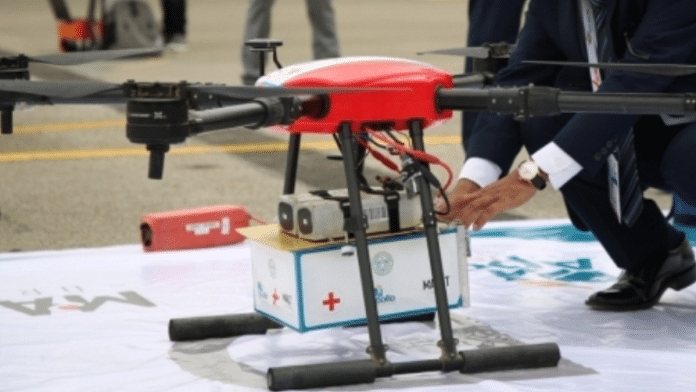- Drones can deliver vital goods to vulnerable populations, overcoming access barriers and enabling faster delivery of lifesaving supplies.
- The World Economic Forum’s Medicine from the Sky initiative is using drones to deliver vaccines and medicine to remote areas in India.
- More than 300 vaccine delivery trials have already been completed, with plans to expand and reach more communities.
The impact of drones delivering vaccines
By delivering medical goods to hard-to-reach places, drones have helped save lives across the world. Doctors Without Borders have tested them to help tackle tuberculosis in Papua New Guinea and Ebola in Liberia, and GAVI has used them to deliver vaccines in areas without the infrastructure for conventional delivery.
COVID-19 has accelerated the way healthcare providers use drones to deliver medicines and vaccines worldwide because they are particularly useful in places where road connectivity and refrigerated transport are a challenge.
In India, there is an urgency for the public and private sectors to collaborate on drone applications to improve healthcare equity in rural areas. The World Economic Forum’s Medicine from the Sky initiative is accelerating the transformation from inefficient health supply chains to digital, resilient infrastructure that reduces wastage and improves health outcomes. At its core, this project is addressing gaps in healthcare distribution systems by delivering vaccines and medicine to remote areas in India using drones. The initiative is also developing guidance for decision-makers and health systems to analyse the opportunities and challenges of drones delivering vaccines.
What’s the challenge?
Last-mile delivery is a major problem in developing countries. During journeys to certain remote areas medical supplies often get damaged, stranded or lost en route. The COVID-19 crisis highlighted the challenge in reaching rural and isolated communities, as well as the role that emerging technologies such as drones could play in improving access to healthcare and medical supply chains.
Drones have tremendous potential to deliver vital goods to vulnerable populations, overcoming access barriers and enabling faster delivery of lifesaving medicine. However, concerns about privacy, safety and security have overshadowed the potential of drones to transform legacy industries and systems.
The majority of India’s 1.4 billion citizens are served by roughly 30,000 government-run primary healthcare centres, but at least 5-10% of them are inaccessible to medical suppliers owing to geographic locations and natural disasters. The new drone rules issued in 2021 were a positive step towards enabling the use of drones in the region after years of public private consultations and two iterations of policy.
Our approach to drones delivering vaccines
The World Economic Forum launched the Medicine from the Sky initiative in 2019 to deliver vaccines to rural communities. It lies at the intersection of two of the most heavily regulated sectors globally, healthcare and aviation, and involves the southern state of Telangana, Apollo Hospitals and India’s policy think tank NITI Aayog. Medicine from the Sky has set off a policy discussion for further liberalization of the drone rules in India and has opened new avenues for use across healthcare.
“The Medicine from the Sky initiative has demonstrated how the country can successfully make use of cutting-edge drone technology to ensure no one is left behind, in terms of access to primary healthcare. We are hopeful that subsequent phases of this initiative will mainstream drones in healthcare.”
— Jyotiraditya Scindia, Union Minister for Civil Aviation
The Indian project, which used lessons from similar initiatives in Rwanda and Ghana, has completed more than 300 vaccine delivery trials in Telangana to very remote areas, making it the first ever instance in Asia where vaccines are delivered using drones beyond the visual range. The trials were a culmination of efforts inaugurated by Union Minister for Civil Aviation, Jyotiraditya Scindia.
“Medicine from the Sky happens to be one of our distinguished projects as far as innovative use of technology in healthcare is concerned and we were privileged to be the clinical partner in the initiative and share our healthcare experiences. We look forward to continuing working with the World Economic Forum, the Government of Telangana, and other states across the country in this project, which I am sure would be the inception of a new age in enhancing the healthcare supply chain.”
— Sangita Reddy, Joint Managing Director, Apollo Hospitals Healthnet Global
The initiative is now expanding to other parts of the region, particularly the Himalayan belt where isolated communities will be served using drones. Medicine from the Sky was instrumental not just in paving the way for last-mile drone projects in India, but also for the greater liberalization of aviation policy in the region.
“Medicine from the Sky has been a highly collaborative effort that has yielded successful results. The pilot programme has demonstrated how detailed planning at the last mile in consultation with local communities can go a long way in ensuring that the country benefits immensely from drone technology.”
— Anna Roy, Senior Adviser, NITI Aayog
This article previously appeared in the World Economic Forum.
Also read: Why India’s drone market could become a multi-billion-dollar industry in next decade



